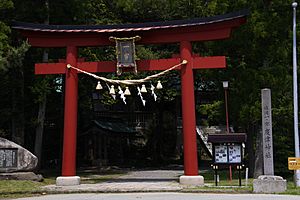Watatsu-jinja facts for kids
Watatsu-jinja (度津神社) is a special Japanese Shinto shrine located on Sado Island in Japan. Sado Island is a beautiful island found in the Sea of Japan, part of Niigata Prefecture. This shrine is a place where people go to worship and connect with ancient Japanese traditions.
Contents
What is Watatsu-jinja?
Watatsu-jinja is a very old and important Shinto shrine. Shinto is the traditional religion of Japan, focusing on the worship of kami, which are spirits or deities. Shrines like Watatsu-jinja are built to honor these kami and are often found in peaceful, natural settings.
Who is Honored at Watatsu-jinja?
This shrine is especially dedicated to a kami named Isonotakeru no mikoto (五十猛命). Ancient stories say that Isonotakeru was a very clever kami who taught people important skills. He is believed to have shown people how to build ships and how to use them to travel across the seas. This made him very important for people living on islands like Sado.
History of the Shrine
Watatsu-jinja was built a very long time ago, even before the 10th century. This means it has been a place of worship for over a thousand years! Over time, it became known as the most important Shinto shrine, or ichinomiya, for the old Sado Province. Even today, it is still considered one of the main ichinomiya in Niigata Prefecture.
Special Events at Watatsu-jinja
Every year, usually in late April, a very exciting event takes place near Watatsu-jinja. It's called yabusame, which is a type of horseback archery. Skilled archers ride horses at full speed and try to shoot arrows at targets. This traditional event happens at the Hachimangū branch shrine of Watatsu, located in the town of Hamochi. It's a thrilling display of ancient Japanese martial arts.
How Important is Watatsu-jinja?
In the past, the Japanese government had a system to rank Shinto shrines based on their importance. Watatsu-jinja was listed as a Kokuhei Shōsha (国幣小社), which means it was considered a nationally significant shrine of the third class. This shows how much respect and importance the shrine held throughout Japan's history.


